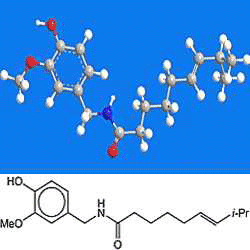
The aromatic amide capsaicin is the “hot stuff” in chili peppers and paprika. It takes its name from Capsicum, the genus to which many peppers belong. It was isolated in 1816; its structure was elucidated in 1920; and it was first synthesized in 1930.
MOTW update:
June 25, 2018
Capsaicin was the Molecule of the Week for August 18, 2008. It is what makes chili peppers and other spicy foods “hot”. It is also used medicinally for treating pain and itching, but it has unpleasant side effects. Now, chemists at Miguel Hernández University of Elche (Spain) and the University of Eastern Piedmont (Italy) report capsaicin derivatives that do capsaicin’s job, then hydrolyze in the body to prevent subsequent unpleasantness.

Learn more about this molecule from CAS, the most authoritative and comprehensive source for chemical information.
Molecule of the Week needs your suggestions!
If your favorite molecule is not in our archive, please send us a message. The molecule can be notable for its current or historical importance or for any quirky reason. Thank you!
Stay Ahead of the Chemistry Curve
Learn how ACS can help you stay ahead in the world of chemistry.

